Central Limit Theorem
As its name implies, this theorem is central to the fields of probability, statistics, and data science. It explains the normal curve that kept appearing in the previous section.
Before we get to the theorem let’s recall some facts from Data 8 and from earlier in this course.
Standard Units
As we have seen earlier, a random variable X converted to standard units becomes
Z=X−μXσXZ measures how far X is from the mean, in units of the SD. In other words Z measures how many SDs above average the value of X is.
By linear function rules, E(Z)=0 and SD(Z)=1 no matter what the distribution of X.
The Standard Normal Curve
Recall from Data 8 that the standard normal curve is defined by a function often denoted by ϕ, the lower case Greek letter phi.
ϕ(z)=1√2πe−12z2, −∞<z<∞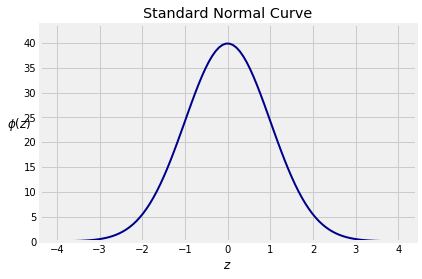
The curve is symmetric about 0. Its points of inflection are at z=−1 and z=1. You observed this in Data 8 and can prove it by calculus.
A Note on Terminology. We will say that the curve has location parameter 0 and scale parameter 1. In the case of normal distributions we will also use the terms mean for the location and SD for the scale, by analogy with the mean and SD of a random variable in standard units. This was the terminology you used in Data 8. Later in the course, we will show that the terminology is consistent with definitions of the mean and SD of random variables that have a continuum of possible values.
The total area under the curve is 1. This requires some work to prove. You might have seen it in a calculus class. We will prove it later in the course using probability methods.
You can think of think of the curve as something resembling the probability histogram of a random variable that has been converted to standard units.
Notice that there is almost no probability outside the range (−3,3). Recall the following figures from Data 8:
- Area between -1 and 1: about 68%
- Area between -2 and 2: about 95%
- Area between -3 and 3: about 99.73%
Normal Curves
The standard normal curve is one of a family of normal curves, each identified by its location and scale parameters, also known as its mean and SD.
The normal curve with mean μ and SD σ is defined by f(x) = 1√2πσe−12(x−μσ)2, −∞<x<∞
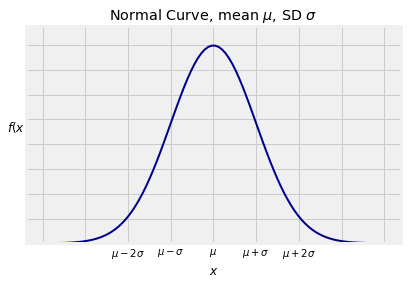
The shape looks exactly the same as the standard normal curve. The only difference is in the scales of measurement on the axes. The center is now μ instead of 0, and the points of inflection are at a distance of σ away from the center instead of 1.
Now for the reason why the normal curve is important:
The Central Limit Theorem
Let X1,X2,… be i.i.d., each with mean μ and SD σ. Let Sn=X1+X2+⋯+Xn. We know that
E(Sn)=nμ SD(Sn)=√nσWhat we don’t yet know is the shape of the distribution of Sn. The Central Limit Theorem (CLT) tells us the rough shape when n is large.
The Theorem
When n is large, the distribution of the standardized sum Sn−nμ√nσ approximately follows the standard normal curve, regardless of the common distribution of the Xi’s.
In other words, when n is large, the distribution of Sn is roughly normal with mean nμ and SD √nσ, regardless of the distribution of the Xi’s.
The Central Limit Theorem is the primary reason for using the SD as the measure of the spread of a distribution.
Exactly how large n has to be for the approximation to be good does depend on the distribution of Xi. We will say more about that later. For now, assume that the sample sizes we are using are large enough for the normal approximation to be reasonable.
A complete proof of this theorem is beyond the scope of this course. A calculation in a later chapter will bring you closer to a proof. For now, just accept it. You have seen plenty of evidence for it in the simulations done in Data 8 and in the exact distributions of sums computed in the previous section.
Example
Suppose the weights of a sample of 100 people are i.i.d. with a mean of 150 pounds and an SD of 15 pounds. Then the total weight of the sampled people is roughly normal with mean 100×150=15,000 pounds and SD √100×15=150 pounds.
Who cares about the total weight of a random group of people? Ask those who construct stadiums, elevators, and airplanes.
You can plot this distribution using the prob140 method Plot_norm. There are three arguments: the interval over which you want the curve to be drawn, the mean, and the SD.
# Approximate distribution of iid sample sum
n = 100
mu = 150
sigma = 15
mean = n*mu
sd = (n**0.5)*sigma
plot_interval = make_array(mean-4*sd, mean+4*sd)
Plot_norm(plot_interval, mean, sd)
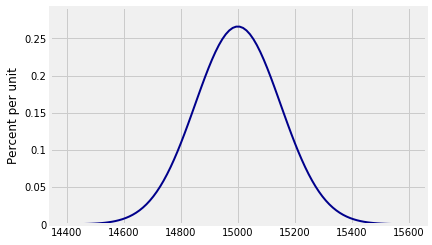
Probabilities Under the Normal Curve
Suppose we want to find the chance that the total weight of the sampled people is less than 15,100 pounds. That is approximately the gold area below. The approximation is in the use of the normal curve.
Notice the argument right_end=15100. That tells Plot_norm the right end of the interval to shade. If there is no left end specified, as in this case, the left end is taken to be the left end of the plot interval.
Plot_norm(plot_interval, mean, sd, right_end=15100)
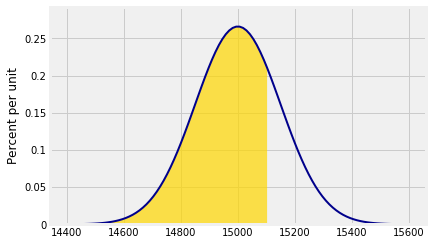
As before, the function that returns all the probability to the left of a point is called the cumulative distribution function (cdf) of the distribution. Call stats.norm.cdf with the appropriate parameters to see that the chance is just under 75%.
stats.norm.cdf(15100, mean, sd)
0.7475074624530771
Approximately what is the chance that the total weight is between 14,800 pounds and 15,100 pounds? Now we specify both left_end and right_end:
Plot_norm(plot_interval, mean, sd, left_end=14800, right_end=15100)

The shaded area is about 65.6%.
stats.norm.cdf(15100, mean, sd) - stats.norm.cdf(14800, mean, sd)
0.65629624272720921
The Standard Normal CDF Φ
There is really only one normal curve that matters – the standard normal curve. All the others are obtained by linear transformations of the horizontal axis. Therefore all the calculations above can be done in terms of the standard normal cdf by standardizing, as follows.
To find the approximate chance that the total weight is less than 15,100 pounds, first standardize the weight and then use the standard normal cdf.
z_right = (15100 - mean)/sd
stats.norm.cdf(z_right) # The standard curve is the default
0.7475074624530771
To find the approximate chance that the total weight is between 14,800 pounds and 15,100 pounds:
z_left = (14800 - mean)/sd
stats.norm.cdf(z_right) - stats.norm.cdf(z_left)
0.6562962427272092
A common notation for the standard normal cdf is the upper case letter Φ, because it is the integral of ϕ:
Φ(x)=∫x−∞ϕ(z)dz , −∞<x<∞This integral, while finite, does not have a closed form formula that can be written in terms of arithmetic operations, powers, trigonometric functions, exponential and logarithmic functions, composition, and other mathematical operations. It has to be approximated by numerical integration. That is why every statistical system has a built-in function such as stats.norm.cdf that provides excellent approximations.
Standardizing and the standard normal cdf Φ together provide a compact notation for areas under all normal curves. We don’t have to use different functions for different values of the parameters.
Under the assumptions of the CLT, for large n we have the approximation
P(Sn≤x) ≈ Φ(x−nμ√nσ) for all xAs you saw in Data 8, approximations often don’t do well in the tails of distributions. If you use the CLT to approximate probabilities of regions that are in the tails, be aware that the approximations might be very rough.
Approximating the Binomial (n,p) Distribution
A binomial (n,p) random variable is the sum of n i.i.d. indicators. If n is large, the CLT says the distribution should be roughly normal, no matter what p is. But we said in Chapter 6 that if n is large and p is small, then the binomial distribution is roughly Poisson.
So which is it: normal or Poisson? Here are two binomial histograms, both of which have large n but rather different shapes.
k1 = np.arange(25, 76)
probs1 = stats.binom.pmf(k1, 100, 0.5)
binom_fair = Table().values(k1).probability(probs1)
Plot(binom_fair)
plt.title('Binomial (100, 0.5)');
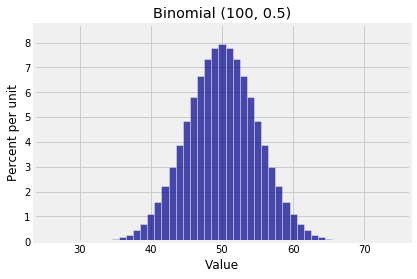
k2 = np.arange(0, 11)
probs2 = stats.binom.pmf(k2, 100, 0.01)
binom_biased = Table().values(k2).probability(probs2)
Plot(binom_biased)
plt.title('Binomial (100, 0.1)');
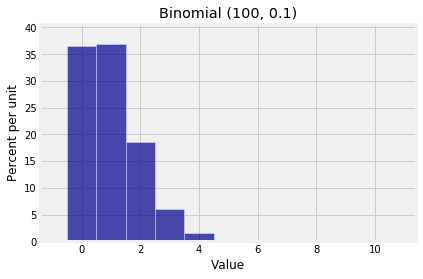
The difference is due to the spread of the distributions. The Poisson approximation applies when the distribution is scrunched up near 0. When the spread is larger so that there are a substantial number of possible values on either side of the mean, then the normal approximation is the one to try.
To quantify this, many texts give a rough threshold depending on n and p so that if n larger than the threshold then the binomial (n,p) distribution is roughly normal. If n is large and the binomial distribution resembles a Poisson, that means n hasn’t crossed the threshold for the normal approximation.
The threshold is variously stated as “the SD √npq is greater than 3” or “both np and nq are greater than 10”, which are not exactly the same but pretty close.
You can see what you think of these guidelines, by comparing the total variation distance between the binomial and the corresponding Poisson and the total variation distance between the binomial and the corresponding normal. However, in this course the choice of the normal versus the Poisson approximation to the binomial is rarely going to be a problem, because when the values of n and p are such that you have a doubt about which to use, then you are just going to use the exact binomial probabilities.
Here is the binomial (100, 0.5) distribution and the approximating normal curve. The parameters of the curve are np=50 and √npq=5.
Plot(binom_fair)
Plot_norm((25, 75), 50, 5, color='red')
plt.xticks(np.arange(25, 76, 5))
plt.title('Binomial (100, 0.5) and its Normal Approximation');
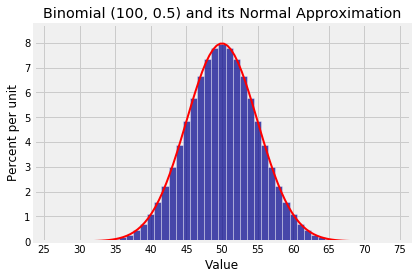
Notice how the points “mean ± SD” =50±5 are the points of inflection of the curve.
